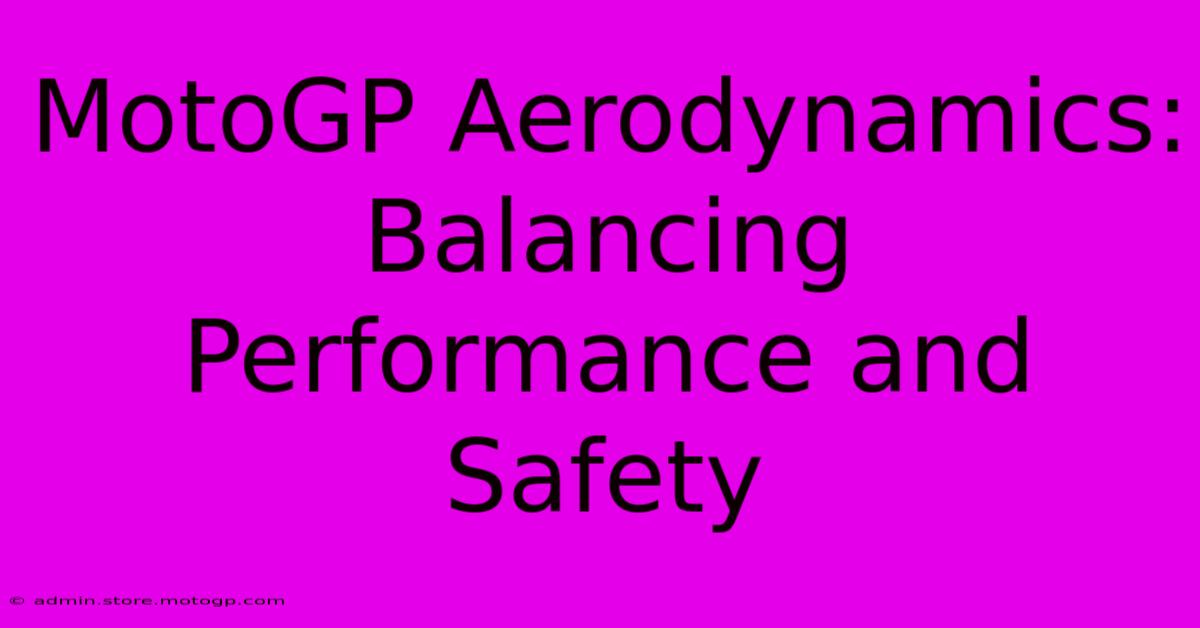MotoGP Aerodynamics: Balancing Performance And Safety

Table of Contents
MotoGP Aerodynamics: Balancing Performance and Safety
MotoGP, the pinnacle of motorcycle road racing, is a relentless pursuit of speed and performance. A crucial element contributing to this pursuit is aerodynamics. The complex interplay of air pressure and airflow around a MotoGP bike significantly impacts its speed, stability, and ultimately, the safety of the rider. This article delves into the fascinating world of MotoGP aerodynamics, exploring the delicate balance between performance gains and the inherent safety risks.
The Science of Speed: How Aerodynamics Impacts MotoGP Performance
Aerodynamic advancements have revolutionized MotoGP. Sophisticated wings, winglets, and fairings aren't just aesthetic additions; they are meticulously engineered components designed to manipulate airflow for specific advantages:
Downforce and Grip:
- The primary goal: Generating downforce is paramount. This downward force presses the tires firmly onto the track, enhancing grip, especially during cornering at high speeds. Increased grip translates directly into faster cornering speeds and improved lap times.
- Wing design: The wings and winglets, often resembling those found on Formula 1 cars, create this downforce by deflecting air downwards. Their size, shape, and angle are carefully optimized to maximize downforce while minimizing drag.
- Fairing optimization: The fairing itself, the bodywork surrounding the motorcycle, is also sculpted to manage airflow efficiently. This includes carefully designed channels and surfaces to minimize turbulence and maximize downforce.
Drag Reduction:
- The friction factor: While downforce is crucial, excessive drag can significantly hinder top speed. Drag is the resistance created by air pushing against the moving motorcycle.
- Streamlined design: MotoGP engineers strive for a balance. They aim to minimize drag by streamlining the bike's profile, reducing the surface area exposed to the oncoming airflow.
- Computational Fluid Dynamics (CFD): Sophisticated software like CFD plays a vital role in optimizing both downforce and drag. It allows engineers to simulate airflow around the motorcycle and refine designs virtually before physical testing.
The Safety Equation: Managing the Risks of Aerodynamic Enhancements
While aerodynamic advancements enhance performance, they also introduce safety considerations:
High-Speed Instability:
- The downside of downforce: Excessive downforce can sometimes lead to instability at high speeds, especially during sudden changes in direction or wind gusts. The increased grip can make the bike overly sensitive to changes in airflow.
- Wheel lift: In extreme cases, significant downforce can even cause the front wheel to lift unexpectedly, leading to a loss of control. This is particularly relevant with aggressive aerodynamic packages.
- Rider control: The rider must be capable of managing these effects, requiring exceptional skill and adaptability.
Crash Consequences:
- Aerodynamic components as hazards: The very wings and winglets designed to improve performance can become dangerous projectiles in a crash. These components, often made from carbon fiber, can break off and cause further injuries to the rider or other competitors.
- Safety regulations: The governing body, Dorna Sports, imposes strict regulations on aerodynamic components to mitigate these risks. These regulations limit size, strength, and placement to ensure a reasonable balance between performance and safety.
The Future of MotoGP Aerodynamics: Continuous Evolution
The pursuit of aerodynamic perfection in MotoGP is an ongoing process. Teams constantly refine their designs, using advanced technologies and simulations to push the boundaries of performance. The future will likely see even more sophisticated aerodynamic solutions, pushing the limits of what's possible, while continually striving to maintain the safety of the riders. The balance between speed and safety will remain the crucial challenge, requiring a constant dialogue between engineers, riders, and the governing body. This interplay ensures MotoGP remains at the forefront of technological innovation while preserving the integrity and safety of the sport.

Thank you for visiting our website wich cover about MotoGP Aerodynamics: Balancing Performance And Safety. We hope the information provided has been useful to you. Feel free to contact us if you have any questions or need further assistance. See you next time and dont miss to bookmark.
Featured Posts
-
Cota Merchandise Celebrate The Journey
Feb 19, 2025
-
Best Motorcycle Racing Choosing The Right Fuel
Feb 19, 2025
-
Cota Parking Secrets Save Time And Money
Feb 19, 2025
-
The Greatest Moto Gp Rider A Story Of Resilience
Feb 19, 2025
-
Moto Gp Standings The Championship Story Unfolds
Feb 19, 2025
